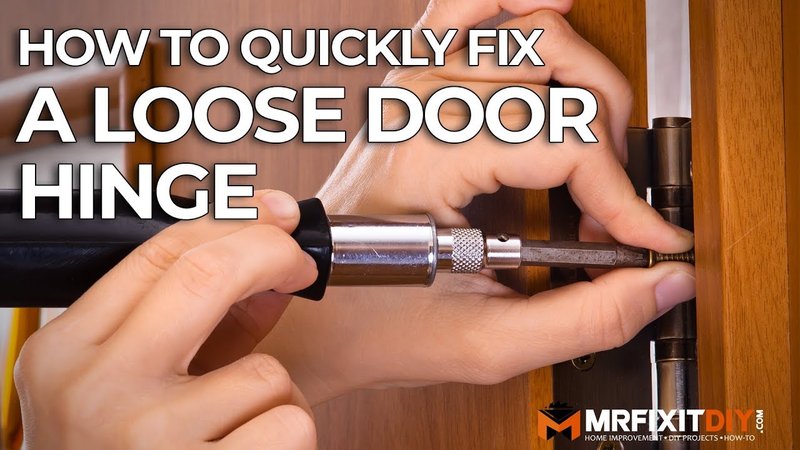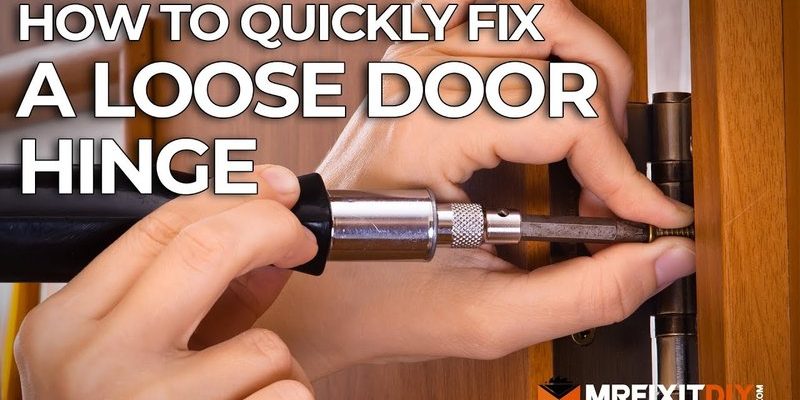
Fixing a loose hinge pin can rejuvenate your door’s functionality and extend its life. You can handle this simple repair without calling in a professional. Don’t worry if you’ve never tackled home repairs before; we’ll walk through the process step by step, just like sharing a recipe over coffee.
Understanding the Hinge Structure
Before diving into the fix, let’s break down how a door hinge works. A *door hinge* consists of two plates, known as knuckles, that pivot around a metal pin. When the door opens and closes, the *hinge pin* keeps everything aligned. If this pin becomes loose, it wobbles in the knuckle, leading to misalignment and noise.
Here’s the thing: if your door isn’t hanging straight, it can affect locking mechanisms and even lead to more wear on the door frame. Think of the hinge pin like a tire on a car. If it’s loose, the ride gets bumpy, and you might end up with bigger issues. So, understanding this structure sets the stage for understanding why fixing a loose hinge pin is important.
Gathering the Right Tools
Before you get started, let’s make sure you’ve got everything you need. Repairs work best when you’re prepared. Here’s what you’ll typically need:
- Screwdriver: A flat-head or Phillips screwdriver, depending on your hinge screws.
- Hammer: For gently tapping the pin in place.
- Wood glue or epoxy: Helps to fill the gap if the hole is too wide.
- New hinge pin (if necessary): Sometimes, a new pin is a better solution.
Having the right tools at hand makes the process smoother. Honestly, there’s nothing worse than starting a project only to realize you’re missing a key item. So, gather your supplies before you dive in!
Removing the Loose Hinge Pin
Now that you’re all set with tools, it’s time to tackle the problem. Begin by supporting the door with something sturdy, like a doorstop or a wedge. This prevents it from falling while you work. Next, locate the hinge where the pin is loose.
Using your screwdriver, carefully remove the screws from the hinge plate attached to the door frame. Depending on the condition of the screws and hinges, you might need some patience here. Once the screws are out, gently tap the bottom of the hinge pin with your hammer while pulling it upward with your fingers. If it’s stubborn, apply a bit more force, but be cautious not to damage the hinge.
Assessing the Damage
After removing the hinge pin, take a close look at both the pin and the knuckle. If the hole in the knuckle is still in good condition, you might just need to replace the pin. However, if you notice that the hole is too wide or damaged, that’s where it gets tricky.
If the hole shows signs of wear, you can fix this by using wood glue or a small piece of wood to fill the gap. Here’s how you can do it:
1. Apply a small amount of wood glue into the knuckle hole.
2. Insert a small dowel or toothpick into the hole for extra support.
3. Allow it to dry completely before reinserting the hinge pin.
This step is crucial. You might be wondering why it’s so important to ensure a tight fit. A loose pin can cause the door to sag over time, making it harder to open or close.
Reinserting the Hinge Pin
Once you’ve assessed and repaired the knuckle, it’s time to reinsert the hinge pin. Start by aligning the pin with the knuckle and gently pushing it back into place. If you encounter resistance, don’t force it. Check the alignment again; a slight twist can make all the difference.
When the pin is securely in the knuckle, reattach the hinge plate to the door frame using your screwdriver. Make sure the screws are tight but avoid over-torquing them, as this might strip the screws or crack the door frame.
Testing the Door Functionality
With everything reassembled, it’s time for the moment of truth. Open and close the door a few times, paying attention to how it moves. Does it swing smoothly? Is there still any squeaking or wobbling? If so, you may need to double-check your work.
Testing the door functionality ensures that the repair holds. If there’s still an issue, you might want to consider replacing the entire hinge assembly. But in most cases, a tight pin will do the trick and keep your door functioning for a long time.
Regular Maintenance for Lasting Repairs
To prevent future issues, regular maintenance is key. Every few months, check your door hinges for signs of wear. Sometimes, just a little lubricant can do wonders to keep everything moving smoothly. Apply a silicone-based lubricant to the hinges to prevent rust and ensure that the pin remains snug in the knuckle.
You might also want to keep an eye on the screws. If they start to feel loose over time, it’s better to tighten them before they cause issues. Regular upkeep can save you from bigger repairs later on.
When to Call a Professional
While most loose hinge issues can be resolved with simple DIY fixes, you might find a situation where calling a professional is the better option. If your door is still misaligned after tightening the hinge pin, a professional can help evaluate if there’s a bigger issue at play, like damage to the door frame or structural problems.
Another scenario might be when you’re dealing with an antique or specialty door. These can require specific skills or knowledge, so it’s wise to consult an expert.
Before you make that call, though, try the steps we’ve discussed. You might be surprised at how easily you can fix a loose hinge pin!
In conclusion, fixing a loose door hinge pin that’s too loose in the knuckle is entirely manageable with the right tools and a bit of patience. By following these steps, you’ll not only save money but also gain the satisfaction of tackling your own home repair. Remember, a well-functioning door makes all the difference in your home’s comfort. So, go ahead and give that hinge a tune-up!
